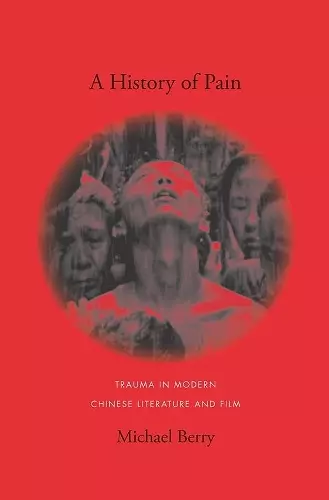A History of Pain
Trauma in Modern Chinese Literature and Film
Format:Hardback
Publisher:Columbia University Press
Published:4th Nov '08
Currently unavailable, and unfortunately no date known when it will be back

Michael Berry takes an innovative look at the representation of six specific historical traumas in modern Chinese history: the Musha Incident (1930), the Rape of Nanjing (1937-38), the February 28 Incident (1947), the Cultural Revolution (1966-76), Tiananmen Square (1989), and the Handover of Hong Kong (1997). He identifies two primary modes of restaging historical violence: centripetal trauma, or violence inflicted from the outside inspiring a reexamination of the Chinese nation, and centrifugal trauma, which originates from within and inspires traumatic narratives projected out onto a transnational vision of global dreams and, sometimes, nightmares. These modes enable Berry to connect portrayals of mass violence to ideas of modernity and the nation. He also illuminates the relationship between historical atrocity on a national scale and the pain experienced by the individual, the function of film and literature as historical testimony, the intersection between politics and art and history and memory, and the particular advantages of modern media, which have discovered new means of narrating the burden of historical violence. As Chinese artists began to probe previously taboo aspects of their nation's history in the final decades of the twentieth century, they created texts that prefigured, echoed, or subverted social, political, and cultural trends. Films such as Hou Hsiao-hsien's City of Sadness and Lou Ye's Summer Palace and novels such as Ye Zhaoyan's Nanjing 1937: A Love Story and Wang Xiaobo's The Golden Age collectively reimagine past horrors and give rise to new historical narratives. A History of Pain acknowledges the far-reaching influence of this art and its profound role in shaping the public imagination and conception--as well as misconception--of modern Chinese history.
The portrayal of historical atrocity in fiction, film, and popular culture can reveal much about the function of individual memory and the shifting status of national identity. In the context of Chinese culture, films such as Hou Hsiao-hsien's City of Sadness and Lou Ye's Summer Palace and novels such as Ye Zhaoyan's Nanjing 1937: A Love Story and Wang Xiaobo's The Golden Age collectively reimagine past horrors and give rise to new historical narratives. Michael Berry takes an innovative look at the representation of six specific historical traumas in modern Chinese history: the Musha Incident (1930); the Rape of Nanjing (1937-38); the February 28 Incident (1947); the Cultural Revolution (1966-76); Tiananmen Square (1989); and the Handover of Hong Kong (1997). He identifies two primary modes of restaging historical violence: centripetal trauma, or violence inflicted from the outside that inspires a reexamination of the Chinese nation, and centrifugal trauma, which, originating from within, inspires traumatic narratives that are projected out onto a transnational vision of global dreams and, sometimes, nightmares. These modes allow Berry to connect portrayals of mass violence to ideas of modernity and the nation. He also illuminates the relationship between historical atrocity on a national scale and the pain experienced by the individual; the function of film and literature as historical testimony; the intersection between politics and art, history and memory; and the particular advantages of modern media, which have found new means of narrating the burden of historical violence. As Chinese artists began to probe previously taboo aspects of their nation's history in the final decades of the twentieth century, they created texts that prefigured, echoed, or subverted social, political, and cultural trends. A History of Pain acknowledges the far-reaching influence of this art and addresses its profound role in shaping the public imagination and conception-as well as misconception-of modern Chinese history.
Twentieth-century China had more than its share of pain, and Michael Berry unfolds the layers of its meanings in diverse contexts and several media. He shows how the pain of groups relates to identity, morality, politics, and to the meaning of 'history' and 'literature.' No serious student of modern China will want to miss his erudite survey. -- Perry Link, professor of East Asian studies, Princeton University Beautifully written, this book is 'educational' in the very best sense... Essential. Choice The book is significant for its extensive survey of the discourse of trauma. JumpCut
ISBN: 9780231141628
Dimensions: unknown
Weight: unknown
432 pages